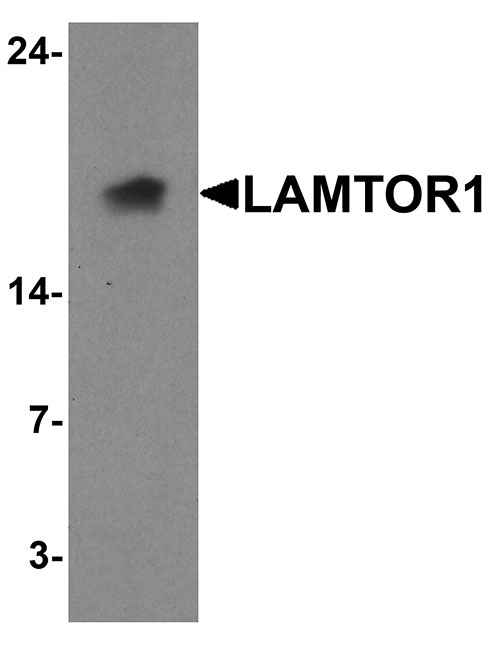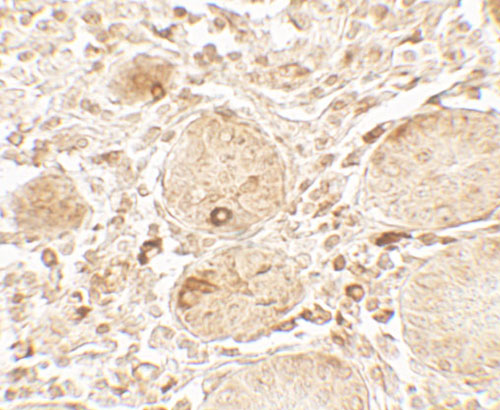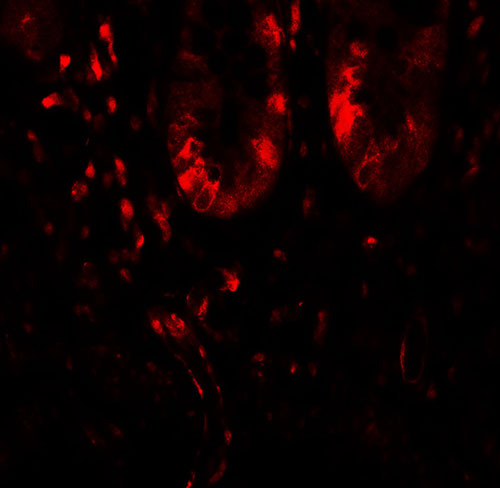LAMTOR1 Antibody
- SPECIFICATION
- CITATIONS
- PROTOCOLS
- BACKGROUND

Application
| WB, IHC-P, IF, E |
|---|---|
| Primary Accession | Q6IAA8 |
| Other Accession | NP_060377, 8923579 |
| Reactivity | Human, Mouse, Rat |
| Host | Rabbit |
| Clonality | Polyclonal |
| Isotype | IgG |
| Calculated MW | Predicted: 18 kDa Observed: 18 kDa |
| Application Notes | LAMTOR1 antibody can be used for detection of LAMTOR1 by Western blot at 1 - 2 µg/ml. Antibody can also be used for Immunohistochemistry starting at 5 µg/mL. For immunofluorescence start at 20 µg/mL. |
| Gene ID | 55004 |
|---|---|
| Target/Specificity | LAMTOR1; LAMTOR1 antibody is human, mouse and rat specific. LAMTOR1 antibody is predicted to not cross-react with other LAMTOR family proteins. |
| Reconstitution & Storage | LAMTOR1 antibody can be stored at 4℃ for three months and -20℃, stable for up to one year. |
| Precautions | LAMTOR1 Antibody is for research use only and not for use in diagnostic or therapeutic procedures. |
| Name | LAMTOR1 {ECO:0000303|PubMed:31001086, ECO:0000312|HGNC:HGNC:26068} |
|---|---|
| Function | Key component of the Ragulator complex, a multiprotein complex involved in amino acid sensing and activation of mTORC1, a signaling complex promoting cell growth in response to growth factors, energy levels, and amino acids (PubMed:20381137, PubMed:22980980, PubMed:29158492). Activated by amino acids through a mechanism involving the lysosomal V-ATPase, the Ragulator plays a dual role for the small GTPases Rag (RagA/RRAGA, RagB/RRAGB, RagC/RRAGC and/or RagD/RRAGD): it (1) acts as a guanine nucleotide exchange factor (GEF), activating the small GTPases Rag and (2) mediates recruitment of Rag GTPases to the lysosome membrane (PubMed:22980980, PubMed:30181260, PubMed:31001086, PubMed:32686708, PubMed:36476874, PubMed:29158492, PubMed:28935770). Activated Ragulator and Rag GTPases function as a scaffold recruiting mTORC1 to lysosomes where it is in turn activated (PubMed:20381137, PubMed:22980980, PubMed:29158492). LAMTOR1 is directly responsible for anchoring the Ragulator complex to the lysosomal membrane (PubMed:31001086, PubMed:32686708). LAMTOR1 wraps around the other subunits of the Ragulator complex to hold them in place and interacts with the Rag GTPases, thereby playing a key role in the recruitment of the mTORC1 complex to lysosomes (PubMed:29285400, PubMed:29107538, PubMed:29123114, PubMed:28935770). Also involved in the control of embryonic stem cells differentiation via non-canonical RagC/RRAGC and RagD/RRAGD activation: together with FLCN, it is necessary to recruit and activate RagC/RRAGC and RagD/RRAGD at the lysosomes, and to induce exit of embryonic stem cells from pluripotency via non-canonical, mTOR-independent TFE3 inactivation (By similarity). Also required for late endosomes/lysosomes biogenesis it may regulate both the recycling of receptors through endosomes and the MAPK signaling pathway through recruitment of some of its components to late endosomes (PubMed:20381137, PubMed:22980980). May be involved in cholesterol homeostasis regulating LDL uptake and cholesterol release from late endosomes/lysosomes (PubMed:20544018). May also play a role in RHOA activation (PubMed:19654316). |
| Cellular Location | Lysosome membrane; Lipid-anchor; Cytoplasmic side. Late endosome membrane; Lipid-anchor; Cytoplasmic side. Note=Recruited to lysosome and endosome membranes through N-terminal myristoylation and palmitoylation |

Thousands of laboratories across the world have published research that depended on the performance of antibodies from Abcepta to advance their research. Check out links to articles that cite our products in major peer-reviewed journals, organized by research category.
info@abcepta.com, and receive a free "I Love Antibodies" mug.
Provided below are standard protocols that you may find useful for product applications.
Background
LAMTOR1 is a 161 amino acid membrane protein belonging to the LAMTOR family. It has been identified to interact with and recruit the four Rag GTPases (Rag A-D) to the surface of lysosomes (1). The mTORC1 kinase complex is a critical component in the regulation of cell growth (2). As part of the ragulator complex, LAMTOR1 recruits the Rag GTPases and the mTORC1 complex to lysosomes, a key step in activation of the TOR signaling cascade by amino acids (3). LAMTOR1 may be involved in cholesterol homeostasis regulating LDL uptake and cholesterol release from late endosomes / lysosomes (4).
References
Sancak Y, Bar-Peled L, Zoncu R, et al. Ragulator-Rag complex targets mTORC1 to the lysosomal surface and is necessary for its activation by amino acids. Cell 2010; 141:290-303.
Kim E, Goraksha-Hicks P, Li L, et al. Regulation of TORC1 by Rag GTPases in nutrient response. Nat. Cell Biol. 2008; 10:935-45.
Wullschleger S, Loewith R, and Hall MN. TOR signaling in growth and metabolism. Cell 2006; 124:471-84.
Soma-Nagae T, Nada S, Kitagawa M, et al. The lysosomal signaling anchor p18/LAMTOR1 controls epidermal development by regulating lysosome-mediated catabolic processes. J. Cell Sci. 2013; 126:3575-84.
If you have used an Abcepta product and would like to share how it has performed, please click on the "Submit Review" button and provide the requested information. Our staff will examine and post your review and contact you if needed.
If you have any additional inquiries please email technical services at tech@abcepta.com.













 Foundational characteristics of cancer include proliferation, angiogenesis, migration, evasion of apoptosis, and cellular immortality. Find key markers for these cellular processes and antibodies to detect them.
Foundational characteristics of cancer include proliferation, angiogenesis, migration, evasion of apoptosis, and cellular immortality. Find key markers for these cellular processes and antibodies to detect them. The SUMOplot™ Analysis Program predicts and scores sumoylation sites in your protein. SUMOylation is a post-translational modification involved in various cellular processes, such as nuclear-cytosolic transport, transcriptional regulation, apoptosis, protein stability, response to stress, and progression through the cell cycle.
The SUMOplot™ Analysis Program predicts and scores sumoylation sites in your protein. SUMOylation is a post-translational modification involved in various cellular processes, such as nuclear-cytosolic transport, transcriptional regulation, apoptosis, protein stability, response to stress, and progression through the cell cycle. The Autophagy Receptor Motif Plotter predicts and scores autophagy receptor binding sites in your protein. Identifying proteins connected to this pathway is critical to understanding the role of autophagy in physiological as well as pathological processes such as development, differentiation, neurodegenerative diseases, stress, infection, and cancer.
The Autophagy Receptor Motif Plotter predicts and scores autophagy receptor binding sites in your protein. Identifying proteins connected to this pathway is critical to understanding the role of autophagy in physiological as well as pathological processes such as development, differentiation, neurodegenerative diseases, stress, infection, and cancer.




